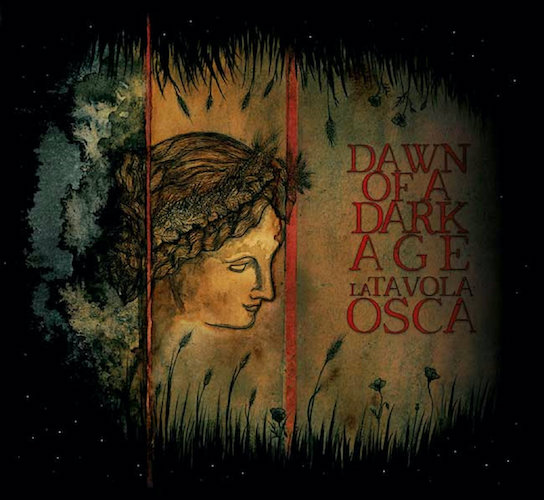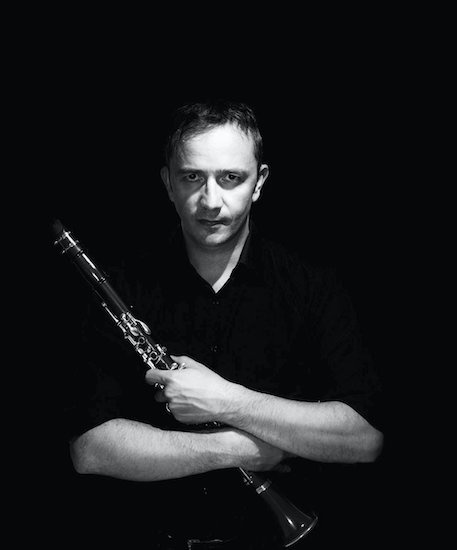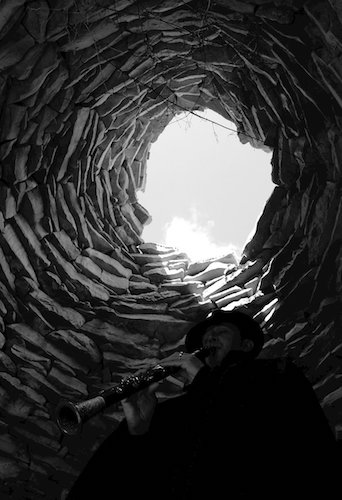
Over time every music fan, including those of us who nourish our needs with extreme metal, discover our strongest preferences. We find what’s most appealing and we tend to stay with it, and we learn what sounds sour to our own ears and avoid it. Each of us also has different degrees of tolerance for musical adventurousness. It might be true that in the genres we love best that tolerance is more limited than in other genres where we usually have only a modest interest, if any at all.
Yet except for the most hidebound listeners, the prospect of discovering music that’s exploratory, that goes off the well-trod paths and introduces us to new terrains, is at least intriguing. And when the adventure succeeds, the discovery can become an even greater thrill than listening to music that satisfies our pre-existing and well-defined individual tastes.
That is precisely what happened to this listener while participating in the adventure of La Tavola Osca, the latest album by the Italian band Dawn Of A Dark Age. It proved to be a thrilling discovery for me, and thus the opportunity to share it with you today is also exciting.

I might have had clues to what kind of adventure La Tavola Osca would provide if I had listened to the previous releases of Dawn Of A Dark Age. The previous discography is extensive. Not one to take timid steps, the band’s principle creator Vittorio Sabelli began by releasing five albums in a row from 2014 through 2017, each of them a separate part of an opus called The Six Elements. He did everything on those albums, with guest appearances by members of such bands as Selvans, Enisum, and Finland’s Graveborne.
Having completed that cycle, Sabelli began again. This new album, which consists exclusively of two very long connected pieces, is described as “the first volume of a saga dedicated to the Samnites people, valiant warriors who inhabited central-southern Italy, as well as crucial moments in the birth and development of the Italian people and the origins of Italy (Viteliù) itself”.
For this new album Sabelli is joined by vocalist Emanuele Prandoni, whose resume includes vocals and/or drumming for many bands we’ve praised at our site — Ancient, Anamnesi, Progenie Terrestre Pura, Ossario. and Simulacro (among others). His vicious, serrated-edge howls on La Tavola Osca sounds like a primal force of nature, providing an element of barbaric intensity that magnifies the music’s most ravaging moments. And his demonic, imperial proclamations in the second track are scary as hell. Credit must also be given to Sparda (Hanternoz, Créatures), who recorded choral vocals, and to Antonia Gust for her vocal session work.
But without intending to diminish those contributions, what makes the album such an adventure is the music created by Vittorio Sabelli. He is a classical and jazz musician, which in part must explain why he felt both inspired to push black metal in new directions and capable of doing so. And apart from the ingenuity of the songwriting, the myriad of sonic textures in the music stand out. Chief among those unusual textures are the sounds of a clarinet.

To be sure, Sabelli roots his music in black metal, generously deploying ferocious blast-beats, distorted guitar riffing, and of course ‘Prandoni‘s harsh vocals. But even in his use of those traditional implements of black metal, he doesn’t follow the old paths in a straight line. Instead, the phases of experience through which he leads us across these two extravagant tracks are remarkably varied, and he borrows from many other musical traditions besides black metal. For example, ethnic Italian music (for want of a better term) plays an equally important role.
Particularly in the first track, the album is marked by electrifying leads that dart, whirl, slither, and soar, creating moments of contagious ebullience. By contrast, the music also leads us into dreamlike reveries, embarks on mentally engrossing yet viscerally appealing prog-metal excursions, and creates diversions into atmospheres of ominous menace and sinister cruelty.
Similarly, the rhythms in the music include compulsively head-moving rocking motifs, pulse-pounding gallops, and plenty of softer passages in which the drums vanish. There’s also a long closing movement in the second track where the percussive pounding has a grim and magisterial quality, accompanied by other percussive beats that create a ritualistic aura.
But there’s also no question that much of the adventure in the album should be credited to Sabelli‘s clarinet performances, and his manipulation of the instrument’s tones. It makes an early appearance in solemn and seductive expressions as Sabelli speaks in Italian in the album’s opening minutes, joined by an acoustic guitar (there are other beautiful acoustic guitar melodies within the album). The folk-inspired music there is sad and soulful, far away from the thorny midnight lands of black metal. How Sabelli gradually segues from that into a ravaging metal race is an early highlight. (When I first encountered that episode in an excerpt of the track that Antiq published on Bandcamp, I stupidly thought the changing tone of the clarinet was an organ or perhaps an accordion. Now I know better).
Sabelli creates a similar experience in the opening of the second long track, in which he uses a piano instead of acoustic guitar as the partner with the clarinet, and creates a doleful swinging march. (Because I have little familiarity with Italian ethnic music, I can only say that this movement put me in mind of music from The Godfather). And here, Sabelli fashions another wonderful segue into heavier metal sounds. But as in the opening of the first track, there is a continuity in the music as it changes — it remains sorrowful, even tragic. And as the intensity mounts, it turns the sorrow into despair.
The clarinet regularly reappears over the album’s course — in passages that are cool and jazzy, accompanied at one point by the hauntingly beautiful voice of Ms. Gust; in other passages where the sound has a hallucinogenic quality; in others where the melody is mournful; and in still others where the soloing is simply wild and exultant (the crescendo near the end of the first long track is a prime example of that).
You’ll get the idea from what I’ve written that the music is dynamic and multi-faceted, and so it is (which is one reason why there’s no risk of losing interest despite the length of each piece). But it’s obvious that a great deal of meticulous planning went into these tracks, because despite all the changes, there are musical and atmospheric themes that unite each composition. And the overarching moods of each track are different from that of the other. In the broadest of terms, Part 1 of the album is more seductive and spirited, while Part 2 is darker, more sorrowing, and ultimately almost apocalyptically desolate in its closing percussive and chanted movement.
In short, La Tavola Osca is a great adventure, a true musical narrative that explores its thematic subject matter without being limited by genre boundaries, and the results are enthralling.
It makes perfect sense that for the release of this new album Dawn Of A Dark Age has formed a partnership with the French label Antiq Records, which in my experience has never released anything “conventional”, nor anything mediocre. The label’s catalogue is full of fascinating music, much of which I’ve written about before. And Antiq‘s artistic devotions extend beyond making fascinating choices in music, and extends to the creation of beautifully crafted packaging for the physical releases. If you haven’t delved into that catalogue, you should do so.
For Las Tavola Osca the cover art was created by Joanna Maeyens, and the mixing and mastering of the record were done by the accomplished musician Stefan Traunmüller (Golden Dawn, Rauhnåcht, The Negative Bias, Wallachia) at Soundtempel Studio. Antiq will release the album on July 10th, in digipack CD and limited A5 deluxe-box formats.
PRE-ORDER:
https://antiqofficial.bandcamp.com/album/dawn-of-a-dark-age-la-tavola-osca
http://antiqrecords.com/shop/
DAWN OF A DARK AGE:
https://dawnofadarkage.bandcamp.com/album/la-tavola-osca
https://www.facebook.com/dawnofadarkage

Goddamn, what a band! Thanks Islander!
I’m so glad you’re liking what you hear!
Hm.. This is a really good find!
Very strange, awful score in AMG and quite a gem here… i wonder if I’ve ever saw an album being bashed here…
You won’t see an album being bashed here. Our philosophy from the start of the site nearly 10 years ago has been to only write about what we honestly want to recommend. We definitely don’t like everything out there (far from it), but albums that we find mediocre or bad we just ignore.